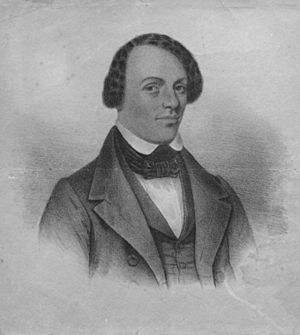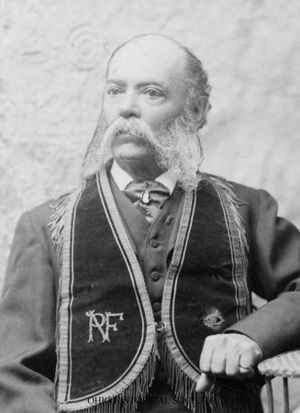George Latimer (escaped slave) facts for kids
Quick facts for kids
George Washington Latimer
|
|
|---|---|

Lithograph by Thayer & Co. (Boston, Mass.)
|
|
| Born | July 4, 1819 Norfolk, Virginia, U.S.
|
| Died | May 29, 1897 (aged 77) Lynn, Massachusetts, U.S.
|
| Spouse(s) | Rebecca Latimer, Charlotte (Williams) Saunders, Mary (Turner) Williams |
| Children | George A. Latimer, William H. Latimer, Margaret Ann Latimer Hawley, and Lewis Howard Latimer |
| Parent(s) | Mitchell Latimer and Margaret Olmsted |
George Washington Latimer (born July 4, 1819 – died May 29, 1897) was a brave man who escaped slavery. His story became a huge deal in Massachusetts, helping to change laws about slavery.
Contents
George Latimer's Early Life
George Washington Latimer was born in Norfolk, Virginia. His mother, Margaret Olmsted, was an enslaved woman. For many years, George was forced to work as a servant.
When he was older, he worked as a driver and a shopkeeper. He was even put in prison sometimes because of his enslaver's debts. Later, he was sold to a man named James B. Gray. Gray owned a shop where Latimer worked. Gray treated Latimer very badly, which made Latimer decide to escape.
Latimer's Escape to Freedom
On October 4, 1842, George Latimer and his wife, Rebecca, ran away. Rebecca was pregnant at the time. They hid on a ship heading north to Baltimore.
From Baltimore, they traveled to Philadelphia. Rebecca pretended to be a servant to her husband, who had lighter skin. Finally, they reached Boston around October 7 or 8. James Gray offered a reward for Latimer's capture.
Arrest in Boston
Soon after arriving in Boston, George Latimer was recognized by a former employee of James Gray. This person contacted Gray. On October 20, Latimer was arrested.
He was brought before a judge, who ordered him to be held in jail.
Public Outcry and Support
News of Latimer's arrest quickly spread through Boston's Black community. A group tried to rescue him, but they were not successful.
Latimer's lawyer, Samuel Edmund Sewall, tried to get him released. He argued that Latimer should have the right to a jury trial to prove his identity. However, the judge said it was a federal matter. He stated that federal laws had to be followed, even if people disagreed with them.
Boston's Reaction
Latimer's arrest caused a huge uproar in Massachusetts. Many people were very angry. A meeting was held where people promised to resist slave catchers. More "Latimer Meetings" took place across the state. Both Black and white abolitionists attended these meetings.
A special newspaper, the Latimer and North Star Journal, was created. It reported on the growing unrest. It said that "fire and bloodshed" were threatened everywhere.
Petitions for Change
The Latimer Committee started two important petitions. The "Great Massachusetts Petition" asked for a law to stop state officials from helping to arrest or hold suspected runaway enslaved people. The "Great Petition to Congress" demanded that laws be passed to end any connection between Massachusetts and slavery.
Even though Latimer gained his freedom while these petitions were still going on, they had a big impact. The petition to the State Assembly had 64,526 signatures and weighed 150 pounds! This petition helped pass the 1843 Liberty Act, also called the "Latimer Law." This law stopped Massachusetts officials from helping to catch runaway enslaved people. It also banned the use of state buildings to hold them.
The petition to Congress was given to John Quincy Adams, but it did not lead to new laws.
Community Action
Latimer's arrest also led to the creation of the New England Freedom Association. It encouraged more teamwork within the Black community in Massachusetts. For example, people raised money to buy Latimer's freedom. Famous abolitionists like Frederick Douglass and Charles Lenox Remond spoke at these fundraising meetings.
Eventually, George Latimer's freedom was bought from James Gray for $400.
Life After Freedom
After gaining his freedom, George Latimer stayed involved in the fight against slavery. He attended anti-slavery meetings and helped collect signatures for the petitions that started during his imprisonment.
Not much is known about Latimer's daily life as a free man. He continued to support the abolitionist movement. In 1851, he helped rescue another escaped enslaved person, Shadrach Minkins. Latimer was paid to watch Minkins's owner.
Latimer worked as a paperhanger for 45 years in Lynn, Massachusetts. He and Rebecca had four children. Their youngest son, Lewis Howard Latimer, born in 1848, became a famous inventor. He worked for well-known inventors like Alexander Graham Bell and Thomas Edison.


